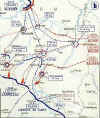
|
||
|
|
Battle
of the
Frontiers
* Dates: 14 to 25 Aug 1914
* Background: In accordance with the Schlieffen Plan, the German army wheeled through Belgium during the first three weeks of the war. By 14 August, the seven German armies had made contact with the French who had been advancing northward in accordance with their own Plan XVII. This included an immediate attack on Alsace-Lorraine, held by Germany since 1870. The Germans were numerically superior on the Western Front and initially fought four separate but related battles along the frontiers of France: Lorraine, Ardennes, River Sambre and Mons.
* Battle of Lorraine: On the eastern end of the front, France's First and Second Armies crossed the frontier into Germany on 14 August, advancing towards Sarrebourg and Morhange. Crown Prince Rupprecht's Sixth Army and General von Heeringen's Seventh Army (total of 25 divisions) delayed counter-attacking until the French had advanced further. The Germans wanted to make it difficult for the French to extricate themselves quickly from battle and transfer north to defend against the German right wing. When French troops did begin to withdraw, the Germans mounted a converging counter-attack on 20 August, defeating France at Morhange but failing to capture the city of Nancy.
* Battle of the Ardennes: West of Metz, the French advanced northwards on 21 August, attacking the German center in the flank as it passed through the thickly wooded hills of the Ardennes. In a thick fog, they engaged Duke Albrecht's Fourth Army and Crown Prince Wilhelm's Fifth Army, the pivot of the Schlieffen Plan. Again, the Germans were numerically superior and by 24 August were able to drive the French back across the Meuse River to the Fortress of Verdun.
* click to enlarge
* Battle of the River Sambre: On the same day that the French were attacking in the Ardennes, further west General von Buelow's Second Army had forced two crossings of the River Sambre between Namur and Charleroi. Some troops were left behind to besiege the fortress at Namur, which fell on 25 August. To the east of the Second Army was von Hausen's Third Army, which had taken Dinant on 15 August. Hausen soon threatened the French Fifth Army's right flank which had moved forward into the Sambre-Meuse area to meet a German attack which was much further to the west than the French had planned. The Sambre was not easy to defend as it flowed through a series of small towns, interfering with defensive maneuvers. On 24 August, the French were forced to retreat. They counter-attacked towards Guise on 29 August but only briefly checked Buelow's advance along the Oise River.
* Battle of Mons: As the French retreated, the BEF under Sir John French moved their four divisions (70,000) into position behind the canal at Mons, Belgium. There, the German First Army under Alexander von Kluck attacked on 23 August. Although more than twice the size of the British side, Kluck was delayed for the entire day by the rapid, accurate fire of Britain's professional soldiers, and the Germans were certain that the BEF had been armed with machine guns. Late in the day, the British found out that the French Fifth Army was in full retreat, giving the BEF no choice but to likewise fall back and avoid being outflanked. The Germans hesitated in their pursuit and thus missed a good opportunity for a route.
* click to enlarge
The Germans had breached the frontier at every point, moving southward in accordance with the Schlieffen Plan, and ensuring that future decisive battles would be fought on French soil. The Allies had retreated in fairly good order, however, giving General Joffre the opportunity to regroup his forces and plan the counter-attack that would be mounted along the River Marne. The German High Command (OHL), meanwhile, had completely overestimated its successes and had therefore prematurely reduced the strength of its crucial right wing by transferring two infantry corps and a cavalry division to the Eastern Front.
*** source: An
Illustrated Companion to the First
World War by Anthony Bruce.